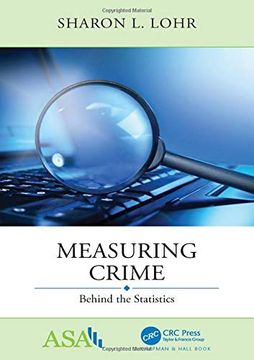Measuring Crime: Behind the Statistics (Asa-Crc Series on Statistical Reasoning in Science and Society) (en Inglés)
Reseña del libro "Measuring Crime: Behind the Statistics (Asa-Crc Series on Statistical Reasoning in Science and Society) (en Inglés)"
Crime statistics are everywhere, but how do you know when they’re valid? If a newspaper report says "the rate of overall violent crime decreased by 0.9 percent," how can you tell where that statistic came from, what it measures, and how accurate it is? Is it worth repeating or sharing? Measuring Crime: Behind the Statistics gives you the tools to interpret and evaluate crime statistics’ quality and usefulness. The book focuses on ways of thinking about crime statistics (no formulas!) and features Eight questions you should ask before quoting a statistic The two sources of information about homicide FBI statistics: what do they measure? How victimization surveys can reflect your experiences even though you were not asked to participate Special considerations when interpreting statistics about sexual assault and fraud Examples of experiments and studies on how to improve crime statistics Two online supplements containing additional details and links to data sources Whether you are a law enforcement professional, journalist, student, or interested citizen, Measuring Crime: Behind the Statistics will tell you how to read statistics as a statistician would. Sharon Lohr, the author of Sampling: Design and Analysis, has published widely about statistical methods for education, public policy, law, and crime. She has been recognized as Fellow of the American Statistical Association, elected member of the International Statistical Institute, and recipient of the Gertrude M. Cox Statistics Award and the Deming Lecturer Award. Formerly Dean’s Distinguished Professor of Statistics at Arizona State University and a Vice President at Westat, she is now a freelance statistical consultant and writer. Visit her website at www.sharonlohr.com. "The book aims to achieve two goals: introduce statistical ideas to a general audience and provide an overview of US crime statistics. These are disparate topics, but in the way they are approached here, there is a strong synergy that reinforces both aspects. One the one hand, the reader's natural curiosity about crime (what is it, how are crime events classified and reported, how reliable are the numbers you see in the newspaper, etc.) will help him/her become interested in the statistical issues and learn these concepts in a practical and concrete setting. And on the other hand, by reading about the statistical issues surrounding crime data, he/she gains a better appreciation for the complexities of crime statistics, eventually acquiring a deeper understanding of them. As a statistician myself, I learned interesting facts about the types of crime, their nomenclature and the possible confusion surrounding them, and how the data are collected and reported. Overall, I think the combination is effective and very well developed in this book." (Jean Opsomer, Westat) "This book is an excellent primer on handling the mass of data and information researchers are faced with. While it is geared toward followers of criminal justice information, much of the book is a very good introduction to survey techniques discussing their strong and weak points. Most importantly, there are very good guidelines and questions that one should employ before citing any data or using data for policy decisions or for reporting on data such as journalists do. The book is written in a non-technical manner and does a very good job of explaining the nuances in reviewing data. Any researcher who utilizes data would find this valuable. While it has specific examples in the criminal justice field, it really is quite useful for any user of data." (Barry Nussbaum, former President American Statistical Association)

